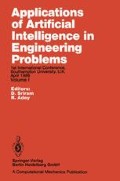Abstract
The development of an expert system involves processing many different types of information; some specific and some vague. Experts do have judgment and heuristic rules based upon their broad knowledge and experience. This judgmental knowledge often involves linguistic descriptors such as “serious,” “possible,” “important,” and so on. The way experts handle such information and reach assessment is also ill-structured and impossible to model using conventional mathematical means. This paper describes the use of fuzzy sets theory to incorporate vague information in the formulation of rules and the querying process when perfect matching no longer exists and contradictory statements are present. Two techniques, fuzzy system identification and the vertex method, are discussed in the treatment of information to obtain the risk functions. The models will be illustrated by means of examples derived from a seismic risk study.
Access this chapter
Tax calculation will be finalised at checkout
Purchases are for personal use only
Preview
Unable to display preview. Download preview PDF.
References
Boissonnade, A. C., Dong, W. M., Shah, H. C. and Wong, F. C., (1985), “Identif ication of Fuzzy Systems in Civil Engineering,” Proceedings of International Symposium on Fuzzy Mathematics in Earthquake Researches, Beijing, China, pp. 48–71.
Buchanan, B. G. and Shortliffe, E. H., (1984), Rule-Based Expert Systems; the MYCIN Experiments of the Stanford Heuristic Programming Project, Addison-Wesley.
Campbell, A., Hollister, N., Duda, V. F. and Hart, P. E., “Recognition of a Hidden Mineral Deposit by an Artificial Intelligence Program,” Science, Vol. 217, No. 3, Sept. (1982).
Mamdani, E. H., Assilian, S., (1975), “An Experiment in Linguistic Synthes is with a Fuzzy Logic Controller,” Int. J. Man-Machine Studies, 7 .
Pedrycz, W., (1984), “An Identification Algorithm in Fuzzy Relational Systems,” J. Fuzzy Sets and Systems 13, pp. 153–167.
Dong, W. M. and Shah, H. C., (1985), “Vertex Method For Computing Function of Fuzzy Variables.” Submitted to Journ al of Fuzzy Sets and Systems .
Duda, R., Hart, P., and Nilsson, N.,(1976), “Sub jective Bayesi an Methods for Rule-based Inference Systems.” Proceedings of National Computer Conference, pp. 1075–1082.
Miyasato, G. H., Dong, W. M., Levitt, R. E. and Boissonnade, A. C., (1985), “Implementation of a Knowledged-Based Seismic Risk Evaluation System on Microcomputers,” submitted to Journal of AI in Engineering.
Nilsson, N., (1980), “Principles of Artificial Intelligence,” Tioga, Palo Alto, California.
Ogawa, H., Fu, K. S., Yao, J.T.P., (1984), “SPERIL II: An Expert System for Da m age Asses s men t of Existing Structures,” Report No. CEE-STR-84–11, Purdue University, IN.
Pedrycz, W., (1984) , “An Identification Algorithm in Fuzzy Relational Systems,” J. Fuzzy Sets and Systems 13, pp. 153–167.
Zadeh, L. A., (1964), “Fuzzy Sets,” J. Fuzzy Sets and Systems, Memo, EERL, No. 64–44, University of California, Berkeley.
Author information
Authors and Affiliations
Editor information
Editors and Affiliations
Rights and permissions
Copyright information
© 1986 Springer-Verlag Berlin Heidelberg
About this paper
Cite this paper
Dong, W.M., Shah, H.C., Boissonnade, A.C. (1986). Treatment of Vague Information in the Development of a Risk Evaluation System — Application to Seismic Risk Analysis. In: Sriram, D., Adey, R. (eds) Applications of Artificial Intelligence in Engineering Problems. Springer, Berlin, Heidelberg. https://doi.org/10.1007/978-3-662-21626-2_23
Download citation
DOI: https://doi.org/10.1007/978-3-662-21626-2_23
Publisher Name: Springer, Berlin, Heidelberg
Print ISBN: 978-3-662-21628-6
Online ISBN: 978-3-662-21626-2
eBook Packages: Springer Book Archive

